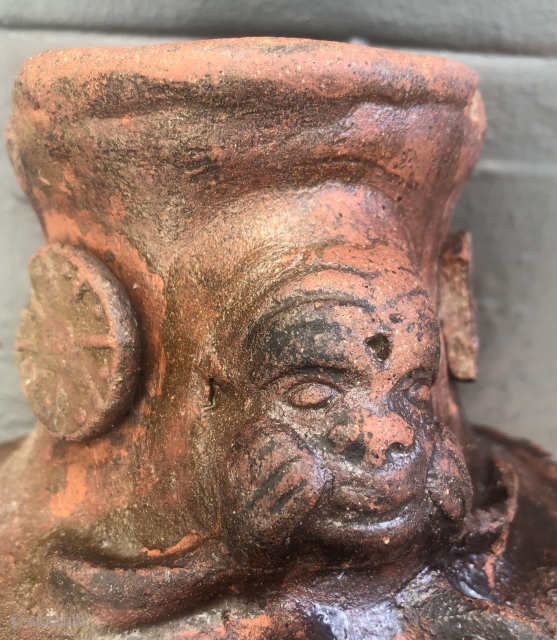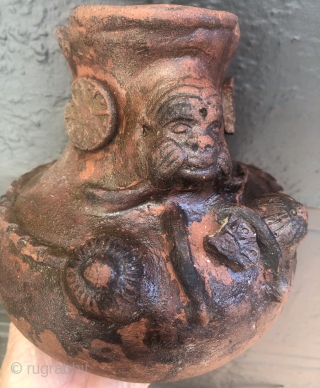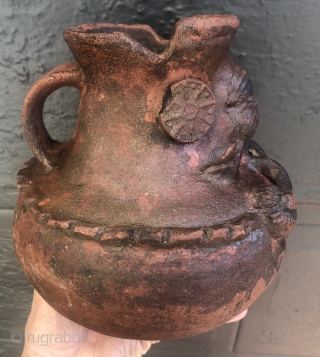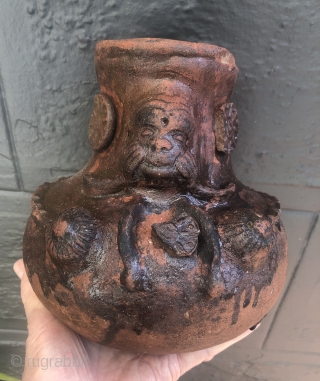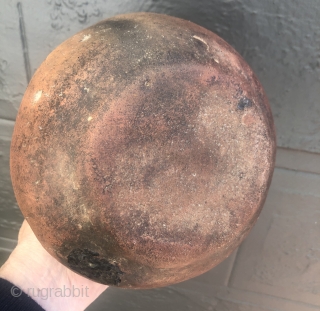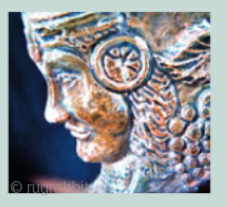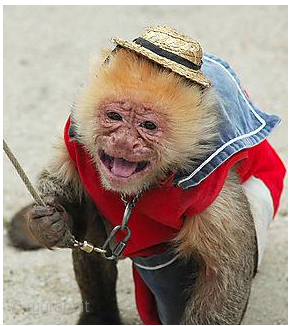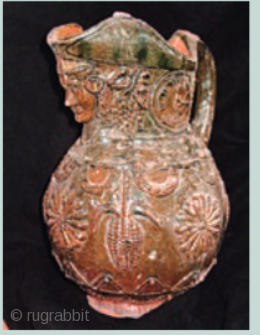Back
Feeling like this nowadays? Here's a possible diversion! Strange ceramic from Bolivia. Probably from the 19th century, it's a unique ceramic pitcher that definitely has a story to tell. The following description is admittedly speculative but... Capuchin monkeys were "discovered" by explorers to South America in the 1500's. These monkeys had long been admired by indigenous peoples for their remarkably high intelligence and fascinating social habits. Known to be the most intelligent monkeys in the Americas, Capuchin monkeys took their current name from a Catholic order of monks who wore brown robes with large hoods and oddly cropped hair. These monkeys were kept as exotic pets both before and after the Spanish conquest of the Americas and in more recent times were faithful companions to organ grinders and street entertainers the world over. The imagery of this pitcher and its intended usage are a bit of a puzzle. a monkey-like head with an strange look on its face holds its hands to its cheeks. Between its legs is a (fragmented) disc with a spoke-like radiating design. There are two more of these discs - one on either side of the head. a necklace like form coils around the body of the vessel terminating in two mounds that have the distinct look of engorged female nipples. When i first got this pot many years ago in Bolivia, i thought that the look on the figure's face and the hand gesture, combined with the nipple-like mounds and spread legs with disc between them, could be an allusion to a birthing scene. i even speculated that it could have been a container that may have belonged to a midwife. In the beginning i didn't associate the face with that of a monkey, but thought of it as having an expression of pain or stress. i certainly have a good imagination, but back then i couldn't come up with anything else to explain the strange imagery of the pot - i still can't, but i recently saw a book on colonial period ceramics from Peru that had an image of a ceramic pitcher with the same theme but a very different execution. See above. Anyway, today I'm not so sure just what this pot is telling us. Surely it has some kind of story to convey, but further research is needed to discover the meaning of this type of portrayal since i now have seen something else like it and realize it is a theme of some kind. Remarkable!
price:
Inquiry
- Home
- Antique Rugs by Region
- Category
- Profiles
- Post Items Free
- Albums
- Benaki Museum of Islamic Art
- Budapest: Ottoman Carpets
- Gulbenkian Museum
- Islamic Carpets. Brooklyn
- Islamic Textiles. Brooklyn
- Konya Museum: Rugs
- MKG, Hamburg
- MMA: Caucasian Carpets
- MMA: Mamluk Carpets
- MMA: Mughal Indian Carpets
- MMA: Ottoman Carpets
- MMA: Safavid Persian Carpets
- MMA: Turkmen Rugs
- McCoy Jones Kilims
- Ottoman textiles. Met
- Philadelphia Museum
- Rugs and Carpets: Berlin
- Seljuqs at the Met
- TIEM, Istanbul: Carpets
- V&A: Classical Carpets
- Vakiflar Carpets: Istanbul
- Baluch Rugs: Indianapolis
- Gallery Exhibitions
- Jaf an Exhibition
- Alberto Levi Gallery
- Andean Textile
- Christie's London: 2016
- Francesca Galloway
- HALI at 40
- ICOC Washington, DC 2018
- Jajims of the Shahsavan
- London Islamic Week April, 2018
- Mongolian Felts
- Navajo Rugs: JB Moore
- Persian Piled Weavings
- SF Tribal & Textile Art Show 2020
- SF Tribal 2019
- Sotheby's: C. Alexander
- Turkish Prayer Rugs
- Turkmen Main Carpets ICOC 2007










